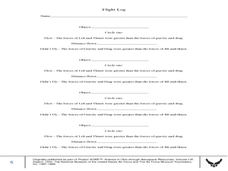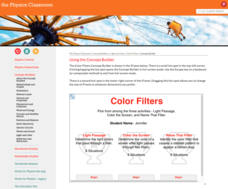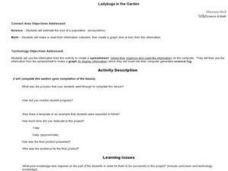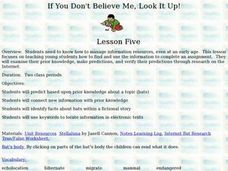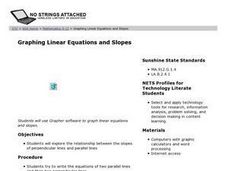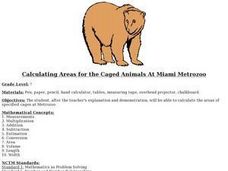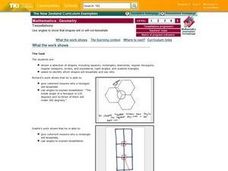Core Knowledge Foundation
Unit 9: The Science of Breakable Things by Tae Keller
A novel study examines The Science of Breakable Things by Tae Keller. Fifth graders participate in daily readings, discussions, and assignments following an "ask, explore, imagine, observe, and understand" routine. A final performance...
Curated OER
Life in a Log
Young scholars identify insects living in rotting logs. In this decomposition lesson, students observe pieces of a rotting log, they look at the insects that have inhabited the log and create a chart that shows their findings.
Physics Classroom
Color Pigments
Objects contain pigments that selectively absorb a wavelength of light, and our eyes only observe a very small range of these wavelengths. Scholars apply these two facts to three different activities. They identify the pigment in an...
Curated OER
Household Things that Fly and Why!!!
Students examine the four forces of flight. In this flight activity, students test to see which types of items will fly. Students make predictions on whether the item will fly or not. Students gain knowledge about lift, gravity, thrust...
Physics Classroom
Color Filters
Filters provide amusing changes to images in applications other than just Instagram! High school pupils apply their knowledge of colored filters to three different interactive sets of puzzles. They identify light colors that pass through...
Curated OER
The Five Senses
Study various objects and help kindergarteners use their five senses to classify the objects. They are presented with various objects and then use their five senses to sort and classify the objects. Then they use a Visual Ranking Tool to...
Physics Classroom
Case Studies: Impulse and Force
Why are gym walls padded and cars required to have air bags? Scholars observe two similar situations, such as those listed above, with only one variable altered. They identify the different variable and determine how the variation...
Curated OER
Weather Journal Log
Students discuss the weather each day and log it on a class chart for a month.
Curated OER
Ladybugs in the Garden
Fifth graders estimate the size a population (ecosystems) Students make a chart from information collected then create a graph (line or bar) from this information. Students do a lesson where they observed, examine, and record data...
Curated OER
The Giving Tree
Fourth graders participate in a shared reading of The Giving Tree. They discuss the relationship between trees and people in the story. Students contribute to a class KWL chart. They create their own KWL chart with at least four things...
Curated OER
Rocks on Parade!
Third graders describe and classify rock samples. In this rock lesson, 3rd graders make inferences about rock samples by observing and measuring them. This lesson contains 5 different stations for the students to go to.
Physics Classroom
Free Fall
Scholars must understand freefall before they learn how objects like airplanes fly. They apply knowledge of velocity and acceleration to predict speed and direction as part of a larger series on vectors and projectiles.
Curated OER
Lesson 4: Author's Purpose
Learners identify the author's purpose in various poems from the book Words with Wings: A Treasury of African-American Poetry and Art. In order to determine the purpose, pupils first observe as the teacher completes a PIES char...
Curated OER
If You Don't Believe Me, Look It Up!
Students learn about bats. In this bats and comprehension lesson plan, students read Stellaluna and share what they know about bats. Students complete a learning log and Internet bat research worksheet.
Curated OER
Irregular Word Fluency, Line it Up
First graders use teacher created irregular word cards to build fluency through a game. In this irregular word cards lesson, 1st graders reply to the teacher when their assigned word card is called. Students mastery or need is...
Curated OER
Caching in Pine's Treasures
Students compile image information about the Junior High School using a digital camera. They survey the area making observations and recording them with the help of portable technology and transferring the data to a spreadsheet and...
Curated OER
Proportional Problems 1
Eighth graders explore representing fractions as ratios and proportions. They model proportions through the use of blocks, LEGO gears and activities with bicycle gears and pedals. Students work with bicycle gear boxes to observe and...
Curated OER
Defining the Difference Between Prokaryotic and Eukaryotic Cells
Young scholars examine microscopic life by conducting a scientific investigation. In this cell analysis lesson, students define the prokaryotic and eukaryotic cells and discuss their word origins. Young scholars view each type of cell on...
Curated OER
Graphing Linear Equations and Slopes
Students explore linear equations, parallel lines, perpendicular lines and slopes. Using computers with graphic calculators and word processing, students examine the relationship between the slopes of perpendicular lines and parallel...
Curated OER
Becoming Comfortable with the Navigation Features
Students, while in the computer lab, log in and go to the American Education System to complete a lesson on the American Education System unit. They review all the terms they may see pop up on their screens (link, save, shift, space,...
Curated OER
Calculating Areas for the Caged Animals At Miami Metrozoo
Seventh graders calculate the area of certain cages at the Miami Metrozoo after observing a teacher demonstration.
Curated OER
Loading B&W Film
Ninth graders explore how to properly load black and white film. They observe black and white film being loaded into the developing tank and students correctly load the film into the developing tank.
Curated OER
Build Fluency /A/
Students are introduced to the letter "A" and play a game to reinforce the printed and sound recognition of the letter "A." In this letter "A" lesson, students observe the teacher model the letter card game. Students participate in...
Curated OER
Tessellations: Use Angles To Show That Shapes Will or WIll Not Tessellate
Students observe a selection of shapes. They identify which shapes will tessellate and justify their answer. Students apply the symmetry and angle properties of polygons to create tessellations.
Other popular searches
- Observation Log Sheet
- Science Observation Log?
- Teacher Observation Log
- Science Observation Log
- Observation Log Plants
- Moon Observation Log
- Observation Log for Infants
- Lunar Cycle Observation Log
- Sky Observation Log
- Weather Observation Log
- Lunar Cyle Observation Log
- Plant Observation Log



